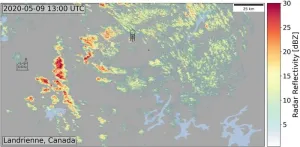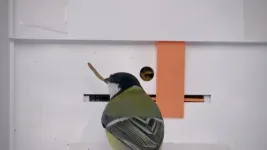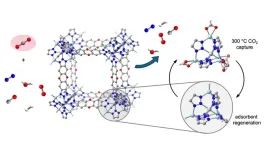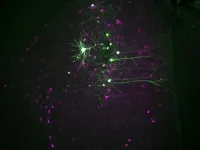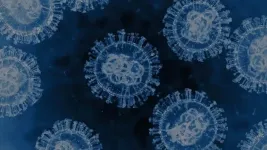(Press-News.org) Without intervention, global plastic waste could double by 2050, a new machine learning study predicts. However, according to simulations by the study’s authors, a mix of policy interventions could cut plastic waste by more than 90% and it could cut plastics-related emissions by a third. With UN treaty negotiations underway, these findings provide a crucial blueprint for tackling the plastic crisis. Plastic production has increased relentlessly for decades, leading to surging plastic waste generation and environmental mismanagement. As plastic degrades, it fragments into micro- and nano-plastics, which harm ecosystems globally – from the Arctic to deep ocean habitats – and pose significant health risks, including heightened cancer risks, cardiovascular disease, and reproductive issues. The plastic lifecycle also intensifies climate change through emissions from oil and gas extraction, production, and waste processing. The disproportionate plastic waste burden on the Global South and the frequency of situating plastic facilities near marginalized communities have sparked pressing environmental justice concerns. Recently, there has been global momentum to address these issues, culminating in a 2022 United Nations resolution to negotiate a legally binding treaty to curb plastic pollution.
To help in this effort, Samuel Pottinger and colleagues developed a novel machine learning model to forecast trends in global plastic production, trade, and waste management to 2050. They also simulated the effects of eight plausible policy interventions to mitigate waste and emissions. Pottinger et al. found that, without interventions, annual mismanaged plastic waste is anticipated to almost double by 2050, reaching 121 million metric tons. Concurrently, annual greenhouse gas emissions from the global plastic system are projected to rise by 37% over the same period. However, the authors also show that a combined policy intervention approach involving a production cap, recycling mandate, packaging tax, and infrastructure investment could reduce mismanaged plastic waste by up to 91% and decrease 2050 plastics-related emissions by about a third. “Collectively, these observations provide timely insight into how to maximize the impact of the UN plastic pollution treaty both as it is being drafted and over the longer time horizon of its implementation,” write Pottinger et al. “It is clear from these results that, with sufficient political will, there is enough technical potential to dramatically reduce mismanaged plastic waste and meaningfully address some of the more insidious associated issues.”
END
Global plastic waste set to double by 2050, but new study offers blueprint for significant reductions
Summary author: Walter Beckwith
2024-11-14
ELSE PRESS RELEASES FROM THIS DATE:
Industrial snow: Factories trigger local snowfall by freezing clouds
2024-11-14
Anthropogenic aerosols, tiny solid and liquid air pollution particles, have masked a fraction of global warming caused by anthropogenic greenhouse gases. Climate researchers have known for decades that anthropogenic aerosols perturb liquid clouds by enabling the formation of a larger number of cloud droplets, making clouds brighter. A new landmark study led by the University of Tartu suggests that anthropogenic aerosols may also influence clouds by converting cloud droplets to ice at temperatures below zero degrees Celsius.
Powerplant Snow
Using satellite observations, climate researchers discovered unique plumes of ice clouds and reduced cloud cover downwind of industrial hot spots ...
Backyard birds learn from their new neighbors when moving house
2024-11-14
Scientists have found a trigger for social learning in wild animals. An experiment on great tits has pinpointed a single factor—immigration—that can cause birds to pay close attention to others, leading them to rapidly adopt useful behaviors. The study is the first to provide experimental support of a long-held assumption that immigrants should strategically use social learning. The study, conducted by scientists from the Max Planck Institute of Animal Behavior (MPI-AB) and the Cluster of Excellence Collective Behaviour at the University of Konstanz in Germany, is published November 14 in PLOS Biology.
Many animals that live in groups learn from one another, but few ...
New study in Science finds that just four global policies could eliminate more than 90% of plastic waste and 30% of linked carbon emissions by 2050
2024-11-14
Berkeley, CA/Santa Barabara, CA (14 November 2024) — A new study released in Science today determines that just four policies can reduce mismanaged plastic waste — plastic that isn’t recycled or properly disposed of and ends up as pollution — by 91% and plastic-related greenhouse gasses by one-third. The policies are: mandate new products be made with 40% post-consumer recycled plastic; cap new plastic production at 2020 levels; invest significantly in plastic waste management — such as landfills and waste collection services; and implement a small fee on plastic packaging. ...
Breakthrough in capturing 'hot' CO2 from industrial exhaust
2024-11-14
Industrial plants, such as those that make cement or steel, emit copious amounts of carbon dioxide, a potent greenhouse gas, but the exhaust is too hot for state-of-the-art carbon removal technology. Lots of energy and water are needed to cool the exhaust streams, a requirement that has limited adoption of CO2 capture in some of the most polluting industries.
Now, chemists at the University of California, Berkeley, have discovered that a porous material can act like a sponge to capture CO2 at temperatures close to those of many industrial exhaust streams. ...
New discovery enables gene therapy for muscular dystrophies, other disorders
2024-11-14
Gene therapy can effectively treat various diseases, but for some debilitating conditions like muscular dystrophies there is a big problem: size. The genes that are dysfunctional in muscular dystrophies are often extremely large, and current delivery methods can’t courier such substantial genetic loads into the body. A new technology, dubbed “StitchR,” surmounts this obstacle by delivering two halves of a gene separately; once in a cell, both DNA segments generate messenger RNAs (mRNAs) that join seamlessly together to restore expression of a protein that is missing or inactive in disease.
Published in ...
Anti-anxiety and hallucination-like effects of psychedelics mediated by distinct neural circuits
2024-11-14
New research suggests that it could be possible to separate treatment from hallucinations when developing new drugs based on psychedelics. The anti-anxiety andhallucination-inducing qualities of psychedelic drugs work through different neural circuits, according to research using a mouse model. The work is published Nov. 15 in Science.
The research shows that decoupling the beneficial effects of psychedelics from their hallucinogenic effects isn’t just a matter of chemical compound design. It’s a matter of targeted neural circuitry.
“In the past, we did this using chemistry by making new compounds, but here we focused on identifying the circuits responsible ...
How do microbiomes influence the study of life?
2024-11-14
UNIVERSITY PARK, Pa. — Microorganisms — bacteria, viruses and other tiny life forms — may drive biological variation in visible life as much, if not more, than genetic mutations, creating new lineages and even new species of animals and plants, according to Seth Bordenstein, director of Penn State’s One Health Microbiome Center, professor of biology and entomology, and the Dorothy Foehr Huck and J. Lloyd Huck Endowed Chair in Microbiome Sciences. Bordenstein and 21 other scientists from around the world published a paper in the leading journal Science, summarizing research that they said drives a deeper understanding of biological ...
Plant roots change their growth pattern during ‘puberty’
2024-11-14
Ghent, November 15, 2024 – Understanding how roots grow can help us develop plants that, for example, are more resistant to drought. Research by Prof. Bert De Rybel’s team (VIB-UGent), in collaboration with the VIB Screening Core and Ghent University, uncovers how roots go through a puberty phase, which could have important implications for developing climate-resilient agriculture. Their work appears in Science.
Plant puberty
Plants, like all living organisms, transition through various developmental stages, starting as a seed, becoming a shoot, and eventually a full-grown, fertile plant. They even go through a sort of ‘puberty’ ...
Study outlines key role of national and EU policy to control emissions from German hydrogen economy
2024-11-14
Hydrogen is set to play an important role in a future low-carbon economy. However, the hydrogen value chain comes with a set of emissions challenges that need to be addressed for hydrogen deployment to help achieve climate goals. A study prepared by the Research Institute for Sustainability – Helmholtz Centre Potsdam (RIFS) with support from Environmental Defense Fund Europe evaluates the potential impact of climate-warming emissions in Germany’s future hydrogen economy and provides recommendations for German and EU policymakers on how to avoid them.
There are hopes that hydrogen can become a carbon neutral alternative to fossil ...
Beloved Disney classics convey an idealized image of fatherhood
2024-11-14
For decades, Disney animations have shaped perceptions of family relationships and gender roles. Although much focus has traditionally been on princesses and female characters, a new study shifts attention to fatherhood and the evolving ideals of masculinity.
"In the history of Disney films, female characters and princess imagery have been widely analyzed, yet the role of masculinity has been explored far less. My research aims to deepen our understanding of the male ideals Disney has constructed and how they reflect ...
LAST 30 PRESS RELEASES:
Post-stroke injection protects the brain in preclinical study
Cardiovascular risk score predicts multiple eye diseases
Health: estimated one in ten British adults used or interested in GLP-1 medications for weight loss
Exercise to treat depression yields similar results to therapy
Whooping cough vaccination for pregnant women strengthens babies’ immune system
Dramatic decline in new cases of orphanhood in Uganda driven by HIV treatment and prevention programs
Stopping weight loss drugs linked to weight regain and reversal of heart health markers
Higher intake of food preservatives linked to increased cancer risk
Mass General Brigham–developed cholera vaccine completes phase 1 trial
First experimental validation of a “150-year-old chemical common sense” direct visualization of the molecular structural changes in the ultrafast anthracene [4+4] photocycloaddition reaction
Lack of support for people on weight loss drugs leaves them vulnerable to nutritional deficiencies, say experts
Dogs’ dinners can have greater climate impact than owners’
Are you ready to swap salmon for sprats and sardines?
1.6 million UK adults used weight loss drugs in past year
American College of Cardiology comments on new dietary guidelines for Americans
American Society of Gene & Cell Therapy and Orphan Therapeutics Accelerator partner to advance and commercialize promising rare disease treatments
One in 14 patients having day case surgery have new or worse chronic pain 3 months after their operation
New study highlights link between eviction rates and gun violence
Heatwaves heat up soil but not toxin levels in rice, study finds
Digital modeling reveals where construction carbon emissions really come from
Turning farm waste into water filters
New study shows how the spleen helps the immune system accept a transplant
New Mayo Clinic study advances personalized prostate cancer education with an EHR-integrated AI agent
Researchers identify novel therapeutic target to improve recovery after nerve injury
Microbes in breast milk help populate infant gut microbiomes
Reprogramming immunity to rewrite the story of Type 1 diabetes
New tool narrows the search for ideal material structures
Artificial saliva containing sugarcane protein helps protect the teeth of patients with head and neck cancer
Understanding the role of linear ubiquitination in T-tubule biogenesis
Researchers identify urban atmosphere as primary reservoir of microplastics
[Press-News.org] Global plastic waste set to double by 2050, but new study offers blueprint for significant reductionsSummary author: Walter Beckwith
